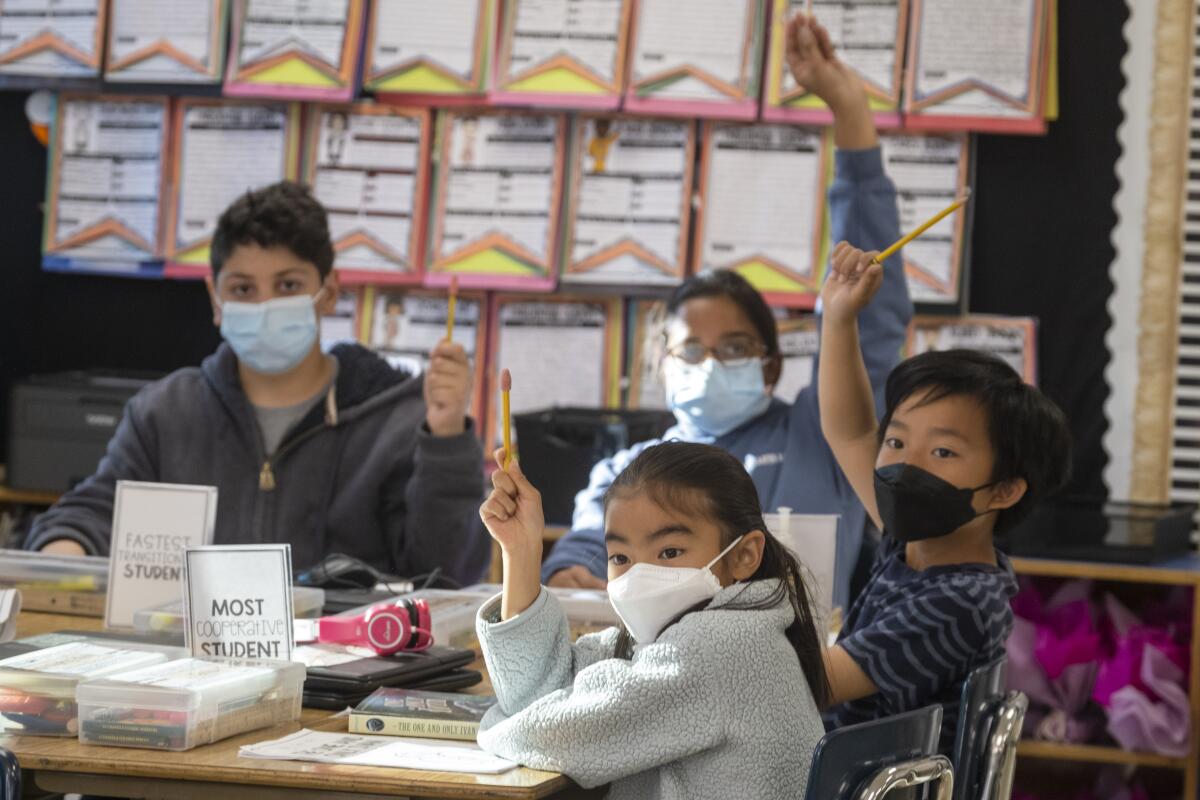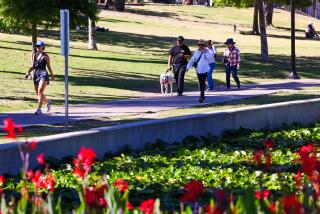School coronavirus outbreaks rise in L.A. County after mask orders are lifted

- Share via
The number of K-12 school coronavirus outbreaks is rising in Los Angeles County after many schools lifted mask-wearing requirements.
Los Angeles County Public Health Director Barbara Ferrer said that there were 14 new outbreaks in schools for the week that ended Thursday. For the previous week, there were four.
The latest figure is the highest such number since early February, during the fall-and-winter Omicron surge. Twelve were at elementary schools and two at high schools.
One of the outbreaks, at a high school, has involved dozens of infected people. It was initially reported to have 26 coronavirus cases linked to one another; the outbreak has since grown to 60 cases in that school.
Among K-12 campuses, “that’s one of the largest outbreaks we’ve ever had at a school since the beginning of the pandemic,” Ferrer said.
The 60-case outbreak was fueled by the more contagious Omicron BA.2 subvariant, Ferrer said, estimated to be 30% to 60% more contagious than the earlier version of Omicron that swept the globe last fall and winter.
The increase in school outbreaks overall is occurring in part because of the lifting of indoor mask requirements, Ferrer said.
“Why would we see more outbreaks? Well, it’s because some of the other protections that we had in place are no longer there,” Ferrer said. It’s clear that masks, when required, “really helped keep transmission in those classrooms low — particularly because, in some of our schools, the ventilation systems are less than perfect.”
There are some schools where many are still wearing masks, and in others, not so much, Ferrer said. “As long as there are people not wearing them, it’s going to be much easier for there to be transmission,” Ferrer said.
Outbreaks are more common among younger children because of the lower vaccination rates in those age groups. Only 31% of L.A. County children age 5 to 11 have completed their primary vaccination series, while 77% of youths 12 to 17 have done so.
Another factor behind the rise in school outbreaks, Ferrer said, is “the change in the state’s quarantine guidance that no longer requires asymptomatic students remaining in school during their quarantine period to wear masks and be tested.”
The latest trend is “concerning because it represents increased transmission of the virus in school settings,” Ferrer said.
“Should we continue to see increases in the number of outbreaks at schools, we’re going to work with our school partners to determine what additional safety measures are warranted,” Ferrer added.
Ferrer reiterated her strong recommendation that everyone in indoor public settings, including in schools, continue to wear masks. She noted that in some other settings where masking is still required — like nursing homes and homeless shelters — there has not been an increase in outbreaks.
While noting that there have been some people who are determined never to put a mask on again, Ferrer said there will be times when it’s important to do so, as is the case right now.
“When you’ve got a person in your midst who’s positive, and you put a good mask on — particularly a respirator, something that fits well, that filters well — and even if there’s a positive person in your vicinity, you’re dramatically reducing your chances of getting infected,” Ferrer said.
Ferrer said other protective steps schools can take include improving ventilation, monitoring students and staff for symptoms, testing anyone with symptoms or who has been exposed to an infected person, sending infected people home, having students who have been exposed wear masks at school and be tested, , and offering routine weekly testing to students who are unvaccinated or not fully vaccinated.
The state requirement to wear masks in indoor K-12 settings ended on March 12, allowing schools to make their own decisions on masks. The L.A. Unified School District lifted its indoor masking requirement on March 23.
After weeks of steady declines, coronavirus cases in Los Angeles County have begun to increase. For the week that ended Thursday, L.A. County was averaging about 879 cases a day, or 61 cases a week for every 100,000 residents. That places L.A. County is a situation of substantial coronavirus transmission rate.
The latest case rate is about 28% higher than it was a week earlier, when the county was reporting about 685 cases a day.
The case rate is also rising in San Francisco. At UC San Francisco’s hospitals, 2% of asymptomatic people who are getting tested are found to have a coronavirus infection, compared with 1% in late March, tweeted Dr. Robert Wachter, chair of the university’s Department of Medicine. The coronavirus positive test rate for those who are visibly ill is now 15%, up from 8% over the same time period.
“Signs of an uptick now unmistakable,” Wachter wrote. “If you’ve let your guard down, time to be more careful.”
But while coronavirus cases are increasing in L.A. County and San Francisco, a number of experts have also expressed optimism that California and the U.S. could see a relatively modest increase in cases and be spared the kind of major surge that places immense pressure on hospitals.
Dr. Eric Topol, director of the Scripps Research Translational Institute in La Jolla, noted on Twitter that in the U.S. Northeast, where BA.2 became dominant earlier than on the West Coast, despite a small increase in cases, there appears “no sign of any surge or rapid ascent” such as that seen in the first Omicron wave that hit last fall.
“Cautiously optimistic,” tweeted Dr. Peter Chin-Hong, a UC San Francisco infectious disease expert.
Indeed, in L.A. County, the number of coronavirus hospitalizations remains low, with 273 coronavirus-positive patients in county hospitals as of Wednesday. That’s close to the lowest figure of the pandemic, when 212 coronavirus-positive patients were in county hospitals on June 12.
Ferrer urged people to get vaccinated and boosted, and recommended that those age 50 and up who qualify for a second booster shot get it. Those eligible for a second booster need to be at least four months removed from their first booster.
“If you’re a person who wants to make sure you’re optimally protected … go ahead and get that second booster dose,” Ferrer said. “Keeping your immune system as primed as possible is not a bad idea when you have a more easily transmitted variant that starts circulating.”
Ferrer also expressed optimism that the spring won’t be as bad as the Omicron surge this past fall and winter, which placed strain on hospitals.
In L.A. County, well over a million people were infected with the earlier Omicron subvariant, Ferrer said, and people infected with that version are unlikely to get infected with BA.2.
Helping matters is that 75% of L.A. County residents age 5 and up have completed their primary vaccination series, and more people are getting their first and second booster doses. In addition, more anti-COVID drugs — including in pill form — are becoming available over time, although it’s still not super easy for people to access all of those drugs yet, Ferrer said.
“We’re going to be acutely aware that this virus is unpredictable and stay prepared and do our best to minimize the tragic consequences,” Ferrer said. “I am hopeful, however, that given what we’ve seen and what we’re doing, we should be able to avoid a really big surge.”
She said she can’t predict the future but hopes “we can continue to do our part and keep ourselves from from having a bad spring.”
One point of worry is that the U.S. government has stopped reimbursing vaccine providers for providing shots to the uninsured. Ferrer made a plea to Congress to strike a deal as soon as possible to replenish that funding.
L.A. County and other vaccine providers are continuing to offer free vaccinations and boosters for the uninsured, but they can’t afford to do so for too long, Ferrer said.
“These dollars save lives,” Ferrer said, in trying to battle a virus that she called “way deadlier than what we’ve experienced with many other viruses, certainly in my lifetime.”
“During the middle of a pandemic is not the time for us to again be shortchanging our communities and their ability to do everything they can to reduce the burden of illness and death,” Ferrer said.
More to Read
Sign up for Essential California
The most important California stories and recommendations in your inbox every morning.
You may occasionally receive promotional content from the Los Angeles Times.











